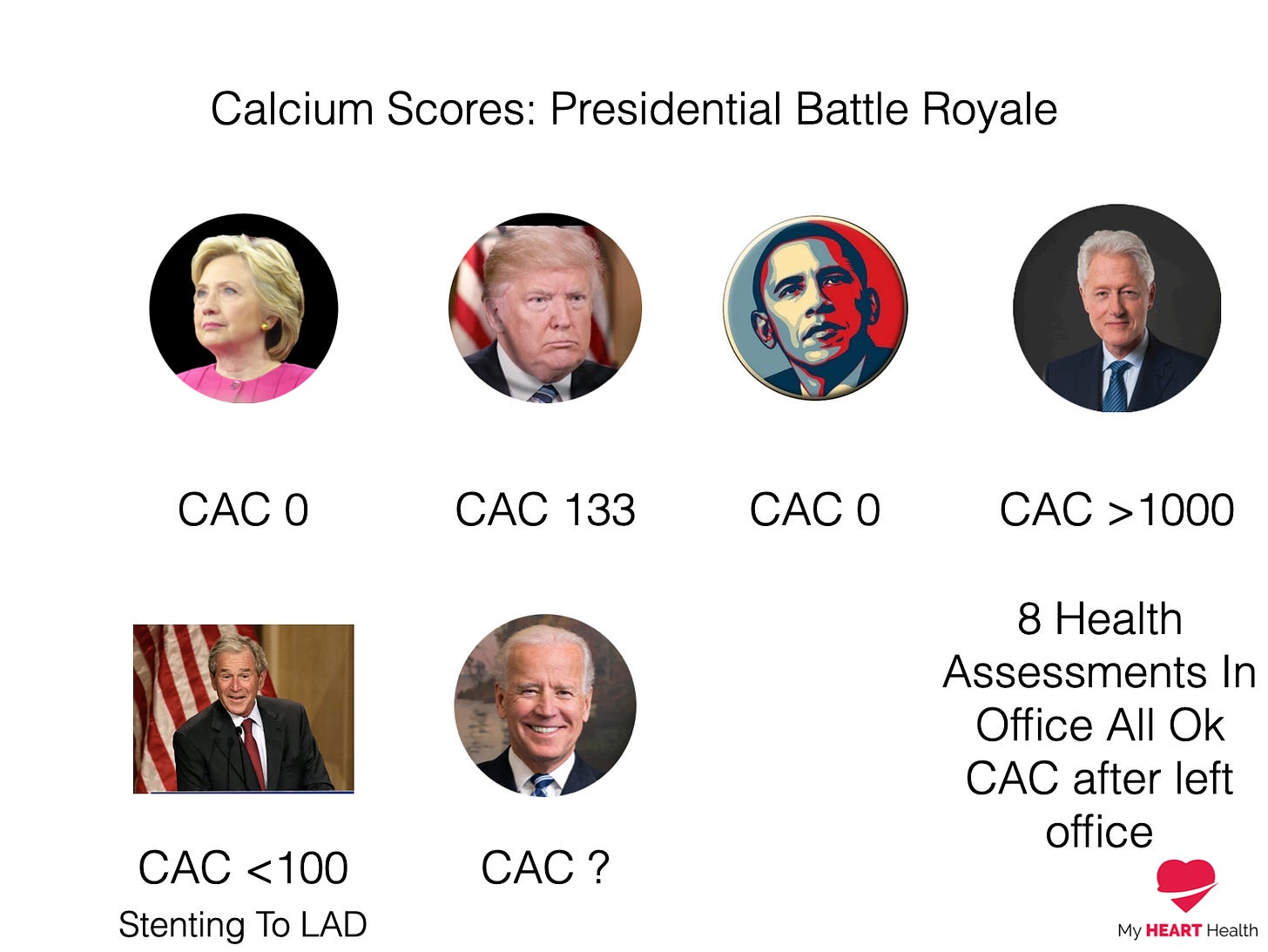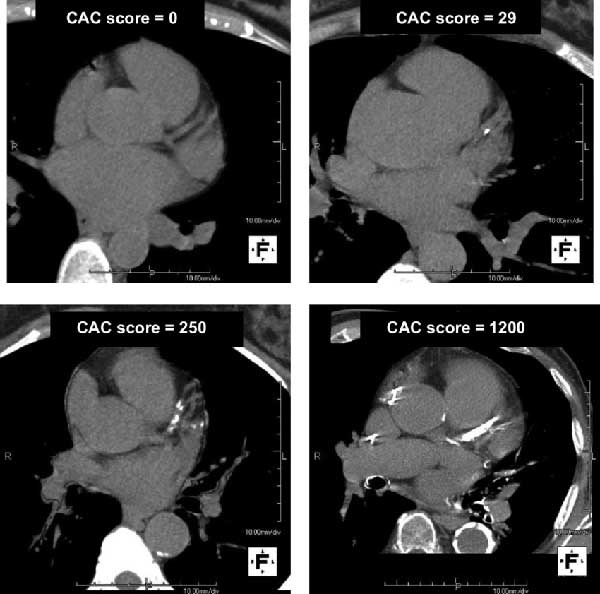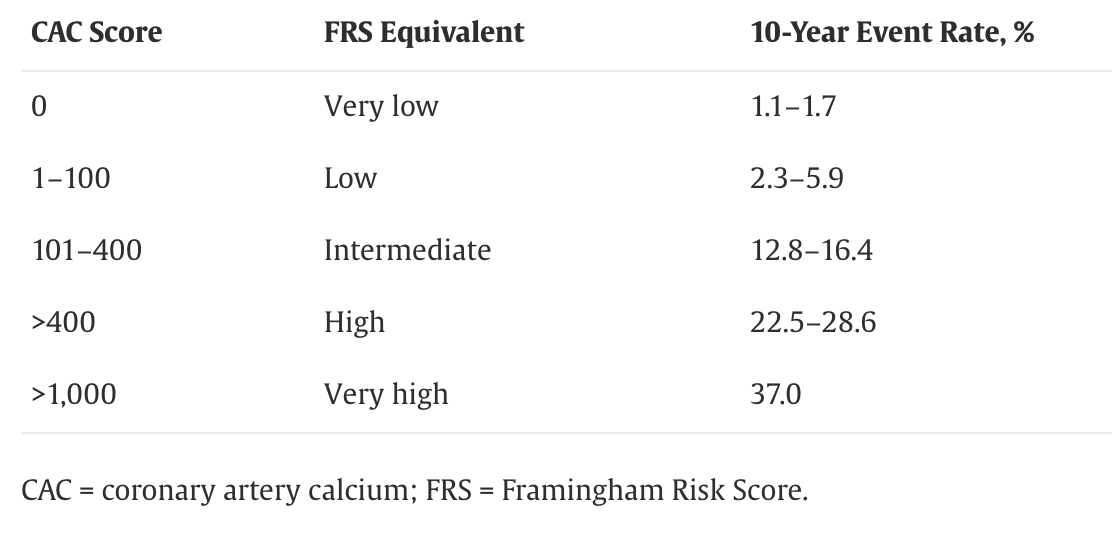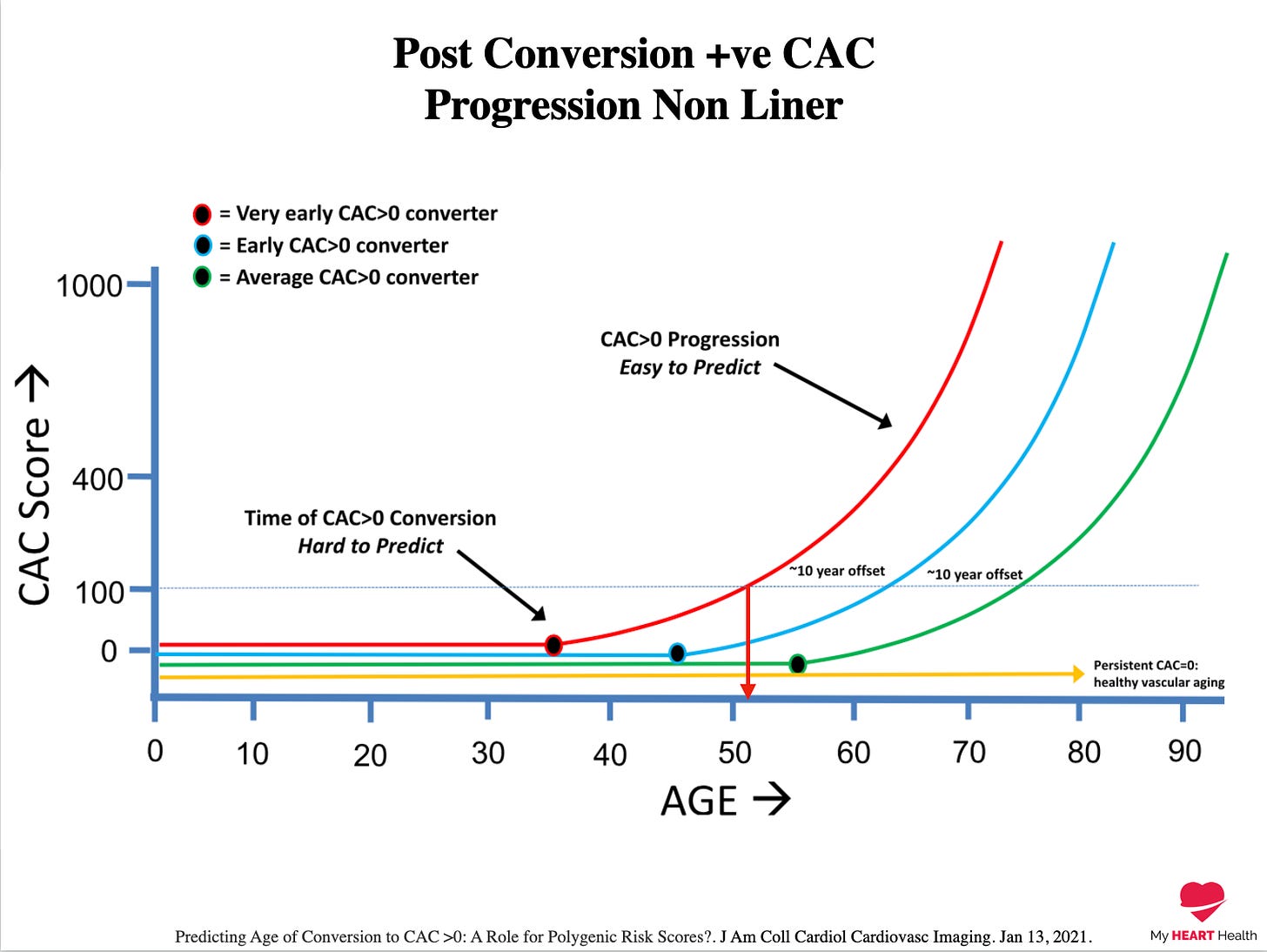Should You Get A Cardiac CT?

A cardiac CT is a scan of the heart and coronary arteries to assess for the presence and extent of advanced atherosclerosis.
Calcification of the coronary arteries is a marker of advanced atherosclerosis.
It is one of the best predictors of near-term risk of a heart attack and overall cardiovascular risk1.
It is such a good predictor of risk that all US astronauts and US Presidents undergo this test.
This was on the back of Bill Clinton ‘passing’ 8 stress tests when in office only to discover that he had severe coronary artery disease on a cardiac CT on leaving office and ultimately needed coronary artery bypass surgery.

I have searched far and wide for Joe Biden’s CAC result but have yet to find it.
There are two types of cardiac CT:
-
CT Coronary Artery Calcium scan. CT CAC Scan.
-
CT Coronary Angiogram. CTCA.
Understanding the difference between these two tests is crucial.
CT Coronary Artery Calcium (CAC) Scan
A CAC scan is a very low-dose radiation CT scan of the heart done without contrast.
Areas of calcification appear white, and the total amount of calcification is assessed. The result is expressed as a Calcium Score in Agatston Units.

A score of 0 means there are no significant deposits of calcified atherosclerosis.
It DOES NOT mean there is no atherosclerosis.
A point we will get to later.
However, it suggests that because the burden of advanced atherosclerosis is small, the risk of a heart attack in the next ten years is likely less than 2-5%2.
It also suggests that the chance of dying from anything, i.e. all-cause mortality, is less than 2% over the following decade.
As the score rises, so does the risk of having a heart attack over the next ten years.
A CAC score of greater than 100 suggests a significantly increased risk of an event over the next ten years.

What About A Score Between 1-99?
This next point is critical to understand.
When you transition from a 0 score to a Non-Zero score is very important.
If you have a CAC score of ‘only’ 10 but are a 40-year-old female, you are at the 97th percentile for your age and sex.
Said plainly, only 3 % of the population will score higher than you.
You are accumulating advanced plaque LONG before you generally should, and a score of 10 in this person should be taken very seriously.

CAC = 0 Means No Statin?
Not so fast.
I hear this ALL the time in those with a high APOB/LDL-C.
You are correct that your 10-year risk is low and that going on lipid-lowering therapy is unlikely to majorly reduce your risk of an event over the next ten years.
However, I am generally not that interested in the next ten years but more in the next 40 to 50 years.
If you have a CAC score of 0 as a 50-year-old white female, you must compare yourself to an age-matched peer.
Only 16% of 50-year-old white females have a score greater than 0.
The average score in this group is 0.
It is not until age 67 that this group, on average, has a CAC score greater than 0.
Always remember the goal is to avoid plaque build-up in your coronary arteries, which means first aggressively treating your risk factors, e.g. APOB/LDL cholesterol.
A CAC of 0 in this group implies low risk, but if your objective is to lower your lifetime risk, you must focus primarily on risk factors.
What If I Wait?
There are some people in this group with a CAC of 0 and high LDL cholesterol that will not go on to develop significant atherosclerosis and, therefore, will be very unlikely to have a heart attack in their lifetime.
The problem is you have no way of knowing who these people will be in advance.
You only get to work that out at the end, looking backwards.
Someday in the future, we may better understand how to discriminate these groups, but for now, we have limited knowledge on answering this question and must make a decision upfront.
Over a 5-year time frame, about 0.7% of those with a CAC score of 0 will have an event.
28% of those with a CAC score of 0 will have transitioned to a Non-Zero score, and the event rates at 15 years are shown below.

Some patients reluctant to go on lipid-lowering therapy take this ‘check-in’ approach.
However, I have yet to meet one who had transitioned to a non-zero score and didn’t regret optimising a modifiable risk factor several years prior.
But it is an option.
We are here to guide, not to compel.
But If It’s All About Risk Factors, Why Do The Test At All?
This is an excellent question.
Currently, no prospective randomised controlled trial demonstrates that doing a CAC scan decreases events.
However….
If you show a patient an image of their coronary arteries with plaque present, they are more likely to have34:
-
Have lower blood pressure.
-
Lower LDL cholesterol.
-
More likely to start a lipid-lowering treatment.
-
More likely to start a blood pressure-lowering treatment.
-
More likely to improve their diet.
-
More likely to increase their activity levels.
These changes are EXACTLY what we hope to get our patients to do, and knowing their CAC score is a reliable way to motivate that change.
It is exactly BECAUSE risk factor control is the key I use this test.
Additionally, a large percentage of my patients also want to know if they have significant coronary artery disease, and this is a way of answering that question for them.
Does it have hard outcome data to support its use? No.
But that does not matter to me.
Answering the question as to whether someone has serious coronary artery disease is a major concern for patients, and they deserve a more reliable answer than only evaluating their risk factors.
Why I don’t order a CT CAC scan in isolation that often.
After everything I have said, this last sentence doesn’t really make much sense.
But let me explain.
A CAC score of 0 does not mean you have excluded all advanced atherosclerosis.
Or even all calcified atherosclerosis, for that matter.
It does not assess for any degree of obstruction of the coronary arteries.
I have several patients who have needed coronary artery stenting and who have a CAC score of 0.
It is not a useful test for those complaining of chest pain.
So what do I request?
This is where we need to discuss the second type of cardiac CT - CT Coronary Angiography (CTCA).
This is where we start to add even more depth and information.
But that is the topic of next week’s newsletter.
Make sure to tune in then!
Coronary artery calcium scanning: past, present, and future. JACC Cardiovasc Imaging. 2015 May;8(5):579-596.
Coronary artery calcium scanning: past, present, and future. JACC Cardiovasc Imaging. 2015 May;8(5):579-596.
Impact of coronary artery calcium scanning on coronary risk factors and downstream testing the EISNER (Early Identification of Subclinical Atherosclerosis by Noninvasive Imaging Research) prospective randomized trial. J Am Coll Cardiol. 2011 Apr 12;57(15):1622-32.
Community-based provision of statin and aspirin after the detection of coronary artery calcium within a community-based screening cohort. J Am Coll Cardiol 2008;51:1337-41.




